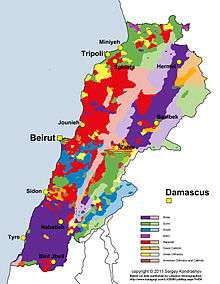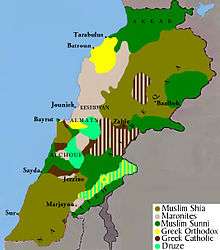Islam in Lebanon
| Total population | |
|---|---|
| 2,535,000-2,975,000[1] | |
| Languages | |
|
Vernacular: Lebanese Arabic | |
| Religion | |
| Islam |
Islam in Lebanon is followed by 59.5% of the country's total population: Shia's make up 27%: Twelvers are the predominant Shia group, followed by Alawites and Ismailis. Sunnis make up also 27%: Sunnis are mainly of the Shafi'i madhhab with pockets of Hanafi and Hanbali. Several large Sufi orders are active in the country, including the Naqshbandi tariqa, and Qadiriyya.
Although not traditionally considered as Muslims, the Druze make up 5.6% of the total population, which under the Lebanese political division (Parliament of Lebanon Seat Allocation) the Druze community is designated as one of the five Lebanese Muslim communities (Sunni, Shia, Druze, Alawi, and Ismaili).[3][4]
Demographics
The number of Muslims in Lebanon has been disputed for many years. There has been no official census in Lebanon since 1932. According to the CIA World Factbook,[11] the Muslim population is estimated at around 59.5%[12] within the Lebanese territory and of the 8.6[13]–14[14] million Lebanese diaspora is believed by some to be about 20% of the total population.
The last census in Lebanon in 1932 put the numbers of Muslims (Shia 20%, Sunni 22%, Druze 7%) at 49% of the population (388,400 of 791,700).[15] A study done by the Central Intelligence Agency (CIA) in 1985 put the numbers of Muslims (Shia 41%, Sunni 27%, Druze 7%) at 75% of the population (1,667,000 of 2,228,000).[15]
Current political and religious issues


Branches
Lebanese Muslims are divided into many branches like Shiites, Sunnites, Druze, Alawites, and Ismailis.
Shia Islam
The Lebanese Shia Muslims are around 27%[12]–29%[16][17] of the total population. Twelvers are the predominant Shia group, followed by Alawites and Ismailis. The Speaker of Parliament is always a Shi'a Muslim, as it is the only high post that Shi'as are eligible for.[18][19][20][21] The Shiites are largely concentrated in northern and western Beqaa, Southern Lebanon, in south Beirut (southern parts of Greater Beirut), Tripoli and Akkar region.[22][23]
Sunni Islam
The Lebanese Sunni Muslims constitute also about 27%[22]–29% [12] of the total population. Sunni notables traditionally held power in the Lebanese state together, and they are still the only ones eligible for the post of Prime Minister[24] Sunnis are mostly concentrated in west Beirut, Tripoli, Sidon, Central and Western Beqaa, and Akkar in the north.[22]
Druze
The Lebanese Druze constitute 5%[12] of the population and can be found primarily in Mount Lebanon and the Shouf District. which under the Lebanese political division (Parliament of Lebanon Seat Allocation) the Druze community is designated as one of the five Lebanese Muslim communities (Sunni, Shia, Druze, Alawi, and Ismaili).[3][4]
See also
- Religion in Lebanon
- Secularism in Lebanon
- Christianity in Lebanon
- Shia Islam in Lebanon
- Sunni Islam in Lebanon
- Druze in Lebanon
References
- ↑ "2012 Report on International Religious Freedom - Lebanon". United States Department of State. 20 May 2013. Retrieved 15 December 2013.
- ↑ "Middle East :: LEBANON". CIA The World Factbook.
- 1 2 Lebanon Country Study Guide Volume 1 Strategic Information and Developments
- 1 2
- ↑ "Contemporary distribution of Lebanon's main religious groups". Library of Congress. 1988. Retrieved 6 December 2015.
- ↑ "Contemporary distribution of Lebanon's main religious groups". theodora.com. 1998. Retrieved 6 December 2015.
- ↑ Tom Najem (July 1998). "The Collapse and Reconstruction of Lebanon" (PDF). University of Durham Centre for Middle Eastern and Islamic Studies. ISSN 1357-7522. Archived from the original (PDF) on 24 March 2012. Retrieved 6 December 2015.
- ↑ "Lebanon: Bureau of Democracy, Human Rights, and Labor - International Religious Freedom Report 2010". U.S. Department of State. 17 November 2010. Retrieved 6 December 2015.
- ↑ "Lebanon: Bureau of Democracy, Human Rights, and Labor - 2012 Report on International Religious Freedom". U.S. Department of State. 20 May 2013. Retrieved 6 December 2015.
- ↑ "The World Factbook". Cia.gov. Retrieved 6 December 2015.
- ↑ "CIA - The World Factbook - Middle East :: Lebanon". CIA Factbook. Washington, DC, USA: Central Intelligence Agency. August 1, 2012. Retrieved August 4, 2012.
- 1 2 3 4 "Statistics Lebanon Beirut-based research firm".
- ↑ Bassil promises to ease citizenship for expatriates
- ↑ "Country Profile: Lebanon". FCO. 3 April 2007.
- 1 2 "Contemporary distribution of Lebanon's main religious groups". Central Intelligence Agency. Retrieved 2013-12-15.
- ↑ "International Religious Freedom Report 2008 – Lebanon". 2008 Report on International Religious Freedom. US Department of State. September 19, 2008. Retrieved 2009-01-08.
- ↑ "Countries with more than 100,000 Shia Muslims" (PDF). Pew Research Center. Retrieved 21 September 2010.
- ↑ "Lebanon-Religious Sects". GlobalSecurity.org. Retrieved 2010-08-11.
- ↑ "March for secularism; religious laws are archaic". NOW Lebanon. Retrieved 2010-08-11.
- ↑ "Fadlallah Charges Every Sect in Lebanon Except his Own Wants to Dominate the Country". Naharnet. Retrieved 2010-08-11.
- ↑ Hajjar, George J. "Aspects of Christian-Muslim Relations in Contemporary Lebanon". hartsem.edu. Hartford, CT, USA: Hartford Seminary. Retrieved August 4, 2012. External link in
|work=(help) - 1 2 3 "Minority Rights Group International : Lebanon : Lebanon Overview". Minorityrights.org.
- ↑ Lebanon Ithna'ashari Shias Overview World Directory of Minorities. June 2008. Retrieved 28 December 2013.
- ↑ "Lebanon". state.gov. Washington, DC, USA: United States Department of State. Retrieved August 4, 2012. External link in
|work=(help)